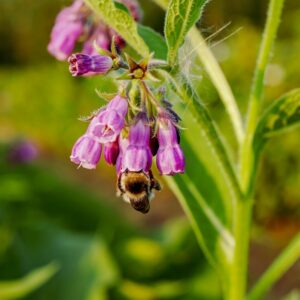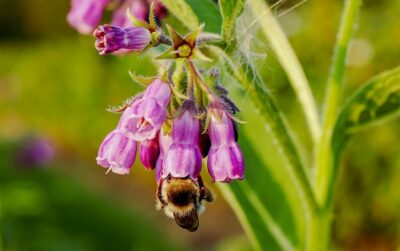Symphytum officinale

Common Names
Comfrey
Common Comfrey
True Comfrey
Knitbone
Boneset
Bruisewort
Consound
Slippery-root
Plant Family
Boraginaceae
Region of Origin
Native to Europe; cultivated especially in the United Kingdom and later in Asia, and much in North America in the 1600s.


Growth Habit and Plant Characteristics
Can be propagated through crown division or root cuttings.
Perennial herb requiring little maintenance once established. Showy purple flowers make this ideal for pollinator gardens. Symphytum officinale thrives in woodland gardens, containers, slopes, meadows, pondscapes, and cottage gardens.
Symphytum officinale grows to a height of 1 to 3 feet with a spread of 8 to 30 inches. The plant’s dark green basal leaves are long and lanceolate (lance-shaped) while the upper leaves are shorter. The leaves and stems are covered in coarse hairs, and its stems are winged. Its bell-shaped flowers in drooping clusters sprout on 2 to 3 foot stems. Symphytum officianle’s flower color is most recognized as purple, but depending on the variety, it can even be pink, blue, yellow, or white, blooming from late spring to early summer.
USDA Hardiness Zones 4 through 8.
Prefers full sun to partial shade.
Adaptable to most soils, but requires well draining soil and prefers a soil pH of 6.0 to 7.0.

QUICK FACTS
- USDA Hardiness Zones 4 through 8.
- Full sun to partial shade.
- Soil pH of 6.0 to 7.0.
- Adaptable to most soils, but requires well draining soil.
Planting Guide
Plant Symphytum officinale seeds outside ¼ inch deep in a prepared bed or container about three weeks before your last frost. Symphytum officinale can also be propagated by root cuttings or crown division.
- Grows best in full to part sun in well draining, compost-rich soils that are kept moist; however, it will tolerate dry soils, as well as clay.
- Water moderately, allowing the soil to dry to a depth of 2 inches. When established, it can withstand periods of drought.
- A pH between 6.0 and 7.0 is ideal. Some afternoon shade is required when growing in regions with hot summers.
- Once planted, it can be difficult to eliminate because any root pieces left behind will grow.
PROBLEMS, PESTS, AND DISEASES

Heading Level 4
Symphytum officinale is rarely bothered by pests or diseases and is deer-resistant, however, slugs or snails may dine on the foliage.
It is considered invasive in the eastern U.S. Planting in containers can help diminish its rapid spread.
